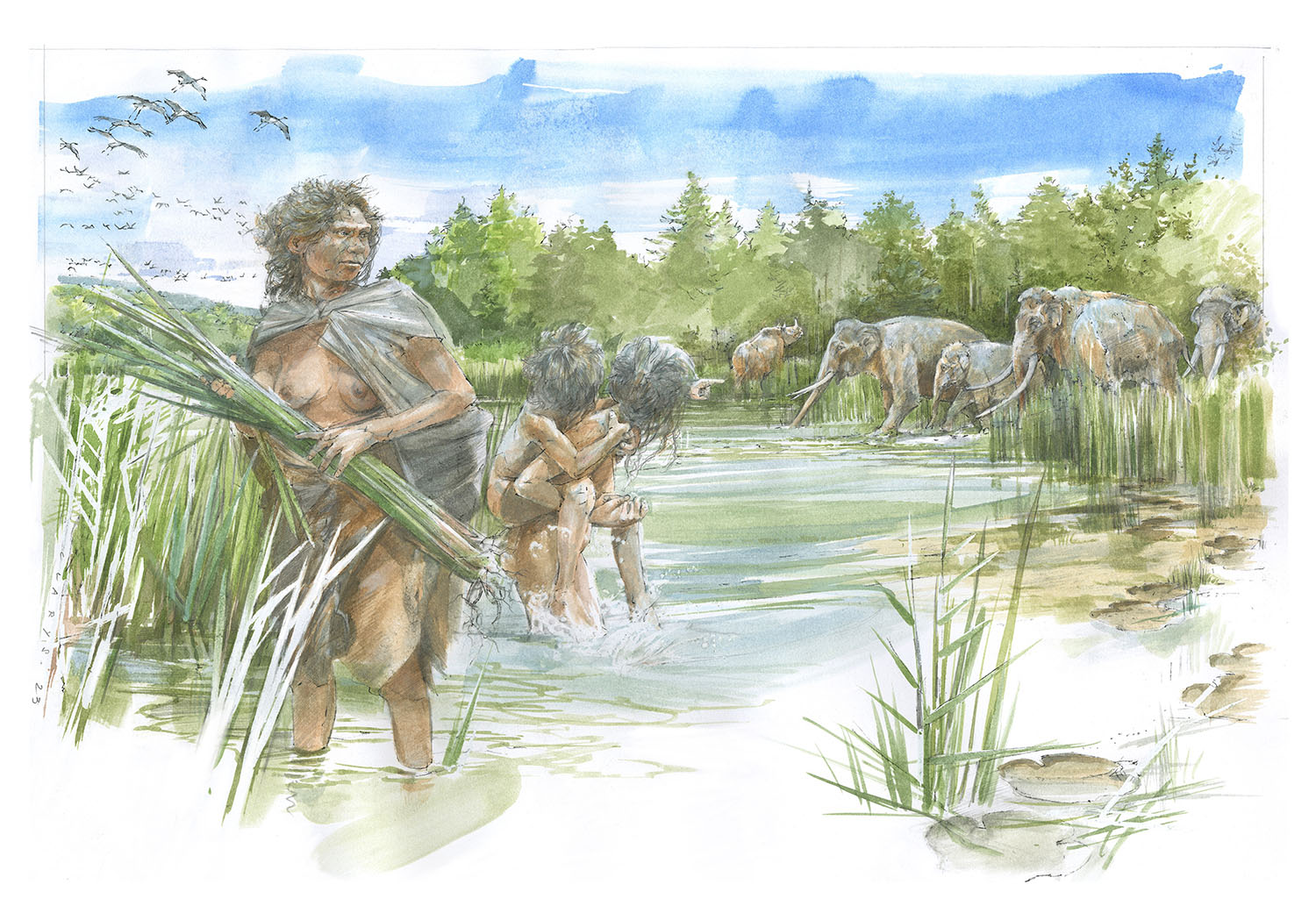News
11.05.2023
300,000-Year-Old Snapshot: Oldest Human Footprints from Germany Found
Three fossil footprints of Homo heidelbergensis discovered among prehistoric elephant tracks at the Schöningen site in Lower Saxony
Schöningen/Tübingen, 05/12/2023. In a study published today in the journal Quaternary Science Reviews, an international research team led by scientists from the University of Tübingen and the Senckenberg Centre for Human Evolution and Palaeoenvironment presents the earliest human footprints known from Germany. The tracks were discovered in the roughly 300,000-year-old Schöningen Paleolithic site complex in Lower Saxony. The footprints, presumably from Homo heidelbergensis, are surrounded by several animal tracks – collectively, they present a picture of the ecosystem at that time. The project is funded by the Ministry of Science and Culture of Lower Saxony and the University of Tübingen.
In an open birch and pine forest with an understory of grasses sits a lake, a few kilometers long and several hundred meters wide. On its muddy shores, herds of elephants, rhinoceroses, and even-toed ungulates gather to drink or bathe. In the midst of this scenery stands a small family of “Heidelberg people,” a species of human long since extinct.
“This is what it might have looked like at Schöningen in Lower Saxony 300,000 years ago,” explains the lead author of the newly published study, Dr. Flavio Altamura, a fellow at the Senckenberg Centre for Human Evolution and Palaeoenvironment at the University of Tübingen (SHEP), and he continues, “For the first time, we conducted a detailed investigation of the fossil footprints from two sites in Schöningen. These tracks, together with information from sedimentological, archaeological, paleontological, and paleobotanical analyses, provide us with insights into the paleoenvironment and the mammals that once lived in this area. Among the prints are three tracks that match hominin footprints – with an age of about 300,000 years, they are the oldest human tracks known from Germany and were most likely left by Homo heidelbergensis.”
The scientists attribute two of the three human tracks at Schöningen to young individuals who used the lake and its resources in a small mixed-age group. “Depending on the season, plants, fruits, leaves, shoots, and mushrooms were available around the lake. Our findings confirm that the extinct human species dwelled on lake or river shores with shallow water. This is also known from other Lower and Middle Pleistocene sites with hominin footprints,” says Altamura. The various tracks at Schöningen offer a snapshot of a family’s daily life and may provide information about the behavior and social composition of hominin groups as well as spatial interactions and coexistence with elephant herds and other, smaller mammals, according to the study. “Based on the tracks, including those of children and juveniles, this was probably a family outing rather than a group of adult hunters,” summarizes the archaeologist and expert on fossil footprints.
In addition to the human tracks, the team analyzed a series of elephant tracks attributable to the extinct species Palaeoloxodon antiquus – an elephant with straight tusks that was the largest land animal at the time and whose adult bulls reached a body weight of up to 13 tons. “The elephant tracks we discovered at Schöningen reach an impressive length of 55 centimeters. In some cases, we also found wood fragments in the prints that were pushed into the – at that time still soft – soil by the animals,” explains Dr. Jordi Serangeli, excavation supervisor at Schöningen, and he adds, “There is also one track from a rhinoceros – Stephanorhinus kirchbergensis or Stephanorhinus hemitoechus – which is the first footprint of either of these Pleistocene species ever found in Europe.”
Press release of the Senckenberg Gesellschaft für Naturforschung, the University of Tübingen and the Lower Saxony Ministry for Science and Culture
Publication:
Flavio Altamura, Jens Lehmann, Bárbara Rodríguez-Álvarez, Brigitte Urban, Thijs van Kolfschoten, Ivo Verheijen, Nicholas J. Conard, Jordi Serangeli 2023. Fossil footprints at the late Lower Paleolithic site of Schöningen (Germany): a new line of research to reconstruct animal and hominin paleoecology. Quaternary Science Reviews. DOI: https://doi.org/10.1016/j.quascirev.2023.108094
Videoclip
External content
Actually, you are supposed to see a video here. To display this content (source: www.xyz.de), please click the "Accept" button below. Please note that by viewing the video, data might be transmitted to third parties or cookies may be stored.
For further information see our privacy policy.
Contact
Judith Jördens
Press Office
Senckenberg Gesellschaft für Naturforschung
Phone 069 7542 1434
pressestellespam prevention@senckenberg.de
Antje Karbe
Press Officer
University of Tübingen
Phone 07071 29-76789
antje.karbespam prevention@uni-tuebingen.de
Dr. Tobias Wulf
Press Officer
Lower Saxony State Office for the Preservation of Monuments
Phone 0511 925 5263
tobias.wulfspam prevention@nld.niedersachsen.de
Dr. Jordi Serangeli
University of Tübingen, Senckenberg Centre for Human Evolution and Palaeoenvironment Research Museum Schöningen
jordi.serangelispam prevention@uni-tuebingen.de
Dr. Flavio Altamura
University of Tübingen, Senckenberg Centre for Human Evolution and Palaeoenvironment
altamuraflaviospam prevention@gmail.com
Prof. Nicholas J. Conard, PhD
University of Tübingen, Senckenberg Centre for Human Evolution and Palaeoenvironment
nicholas.conardspam prevention@uni-tuebingen.de

